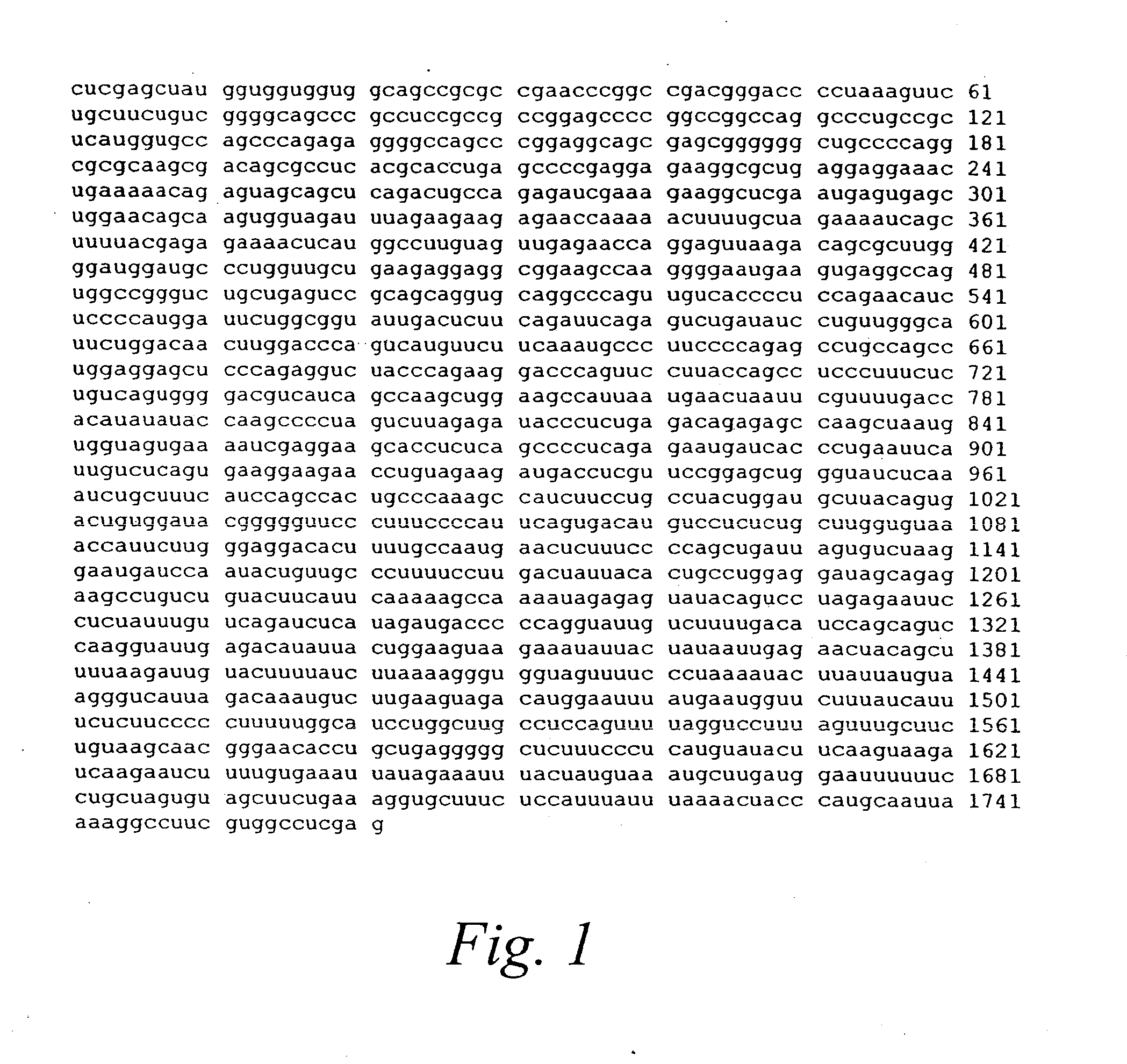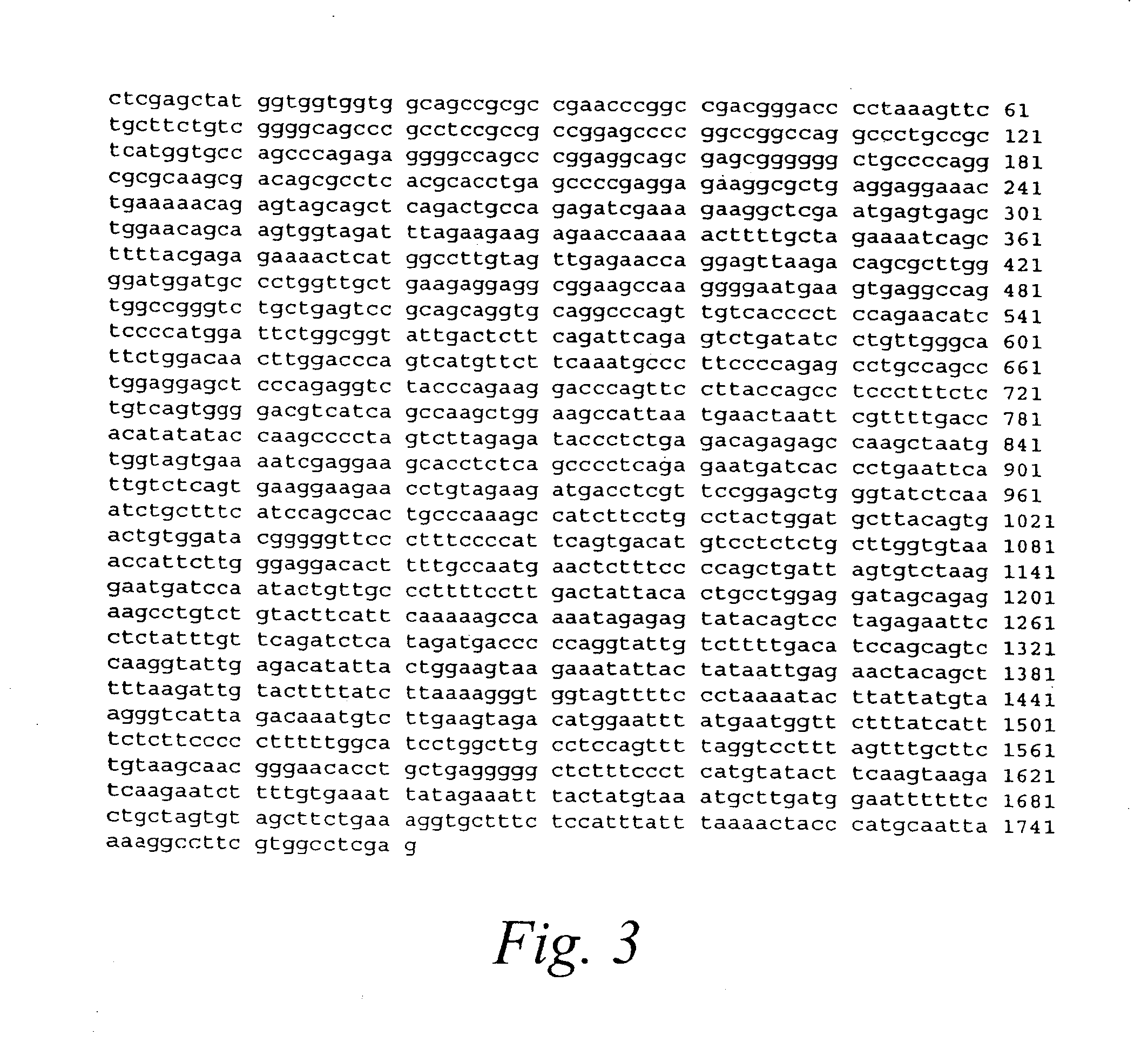Novel Genes, Compositions, and Methods for Modulating the Unfolded Protein Response
a technology of unfolded protein and composition, applied in the field of novel genes, compositions, and methods for modulating the unfolded protein response, can solve the problem that the hac1 homologue has not been identified in the sequence, and achieve the effects of increasing the amount of xbp1 mrna, enhancing protein folding capabilities, and increasing transactivation potential
- Summary
- Abstract
- Description
- Claims
- Application Information
AI Technical Summary
Benefits of technology
Problems solved by technology
Method used
Image
Examples
specific examples
Example 1
Complementary Signaling Pathways Regulate the Unfolded protein Response and are Required for Development
A. Materials and Methods
Stains and General Methods
[0240]The strain N2 (Bristol) was used as the wild-type strain. The strain JJ529 rol-1(e91) mex-1(zu121) / mnC1 [dpy-10(e128) unc-52(e444)] was used to construct IRE1(v33) / mnC1; PEK1(ok275) (Sigurdson et al., 1984). C. elegans strains were cultivated at 20° C. unless otherwise indicated (Brenner, 1974).
Drug Treatments
[0241]For Northern analysis, mixed-stage nematodes grown in liquid culture were treated with 3 mM of DTT (Calbiochem) for up to 8 hours. Heat-shock treatment was performed at 30° C. for 1 hour. For single worm analysis, individual L2 larvae grown on plates were treated with 2.5 mM of DTT or 28 μg / ml of tunicamycin (Calbiochem) for 4 hours. To study survival to tunicamycin, gravid adults were allowed to lay eggs on plates containing tunicamycin (0 to 7.5 μg / ml) for 4 hours and then removed from the plates. Eggs w...
example 2
IRE1-Mediated Unconventionals mRNA Splicing and S2P-Mediated ATF6 Cleavage Merge to Regulate XBP1 in Signaling the Unfolded Protein response
A. Materials and Methods
Cell Culture and Transient DNA Transfection
[0267]Culture methods and media for COS-1 monkey cells were previously described (Kaufman, 1997) and the same methods were applied to MEFs except that fetal bovine serum (FBS) was not heat-inactivated. Wild-type (K1) and S2P-deficient (clone M19) Chinese hamster ovary (CHO) cells were cultured as described (Ye et al., 2000). R1 murine embryonic stem (ES) cells (Joyner, 1989), were plated onto mitomycin C-treated MEF feeder cells in ES cell medium ((Dulbecco's Modified Eagle Medium (GIBCO BRL, Rockville, Md.)) supplemented with 15% heat-inactivated FBS, 0.1 mM (3-mercaptoethanol and 1000 units / ml Leukocyte Inhibitory Factor (GIBCO BRL, Rockville, Md.). COS-1 cells were transfected by either Diethylaminoethyl(DEAE)-Dextran (Kaufman, 1997) or Calcium-Phosphate-BES methods (Ausubel...
example 3
[0289]In vivo activation of IRE1 can be monitored directly by phosphorylation of IRE1 or indirectly by identifying splicing of XBP1 mRNA. By western blot analysis, it is possible to distinguish unphosphorylated IRE1 from phosphorylated IRE1 due to the slower migration of the latter on reducing SDS-PAGE. Because the endogenous level of IRE1 expression is very low, IRE1 protein was detected by immunoprecipitation using an anti-IRE1 antibody and western blot analysis using the same antibody.
A. Materials and Methods
Transient Transfections
[0290]COS-1 monkey cells were transfected by either diethylaminoethyl (DEAE)-dextran (Kaufman, 1997) or Calcium Phosphate-BES methods (Ausubel et al, 1999). Chinese hamster ovary (CHO) cells were transfected by either lipofectAMINE PLUS (Life Technology) or FuGENE6 (Roche). Murine embryonic fibroblasts (MEFs) were transfected by either FuGENE6 (Roche) or Effectine (QIAGEN). IRE1 activation was monitored by immunoprecipitatio...
PUM
| Property | Measurement | Unit |
|---|---|---|
| time | aaaaa | aaaaa |
| time | aaaaa | aaaaa |
| time | aaaaa | aaaaa |
Abstract
Description
Claims
Application Information
 Login to View More
Login to View More - R&D
- Intellectual Property
- Life Sciences
- Materials
- Tech Scout
- Unparalleled Data Quality
- Higher Quality Content
- 60% Fewer Hallucinations
Browse by: Latest US Patents, China's latest patents, Technical Efficacy Thesaurus, Application Domain, Technology Topic, Popular Technical Reports.
© 2025 PatSnap. All rights reserved.Legal|Privacy policy|Modern Slavery Act Transparency Statement|Sitemap|About US| Contact US: help@patsnap.com



